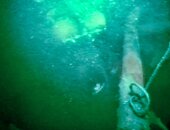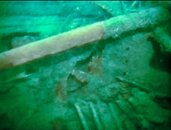I thought it interesting that at least one member now refers to diving between 100 and 130 ft as the "deep air" range. I think that is kinda ridiculous.
I have done a good bit of diving around 180 ft + on air, and my primary problems have been narcosis and nothing that I can identify as a problem with gas density - but I do know from experience that you can't work too hard at depth, and if/when you do, it is really hard to get caught up again.
I don't agree with the general idea that the narcosis from deep air is necessarily a huge danger (particularly to those that do it relatively often, or who have acclimated to it or to people that have demonstrated the ability to function pretty well below, say 160 feet many dozens of times.
Obviously, being impaired reduces safety, but safety itself is a relative thing. If we strived for total safety, we would never leave the swimming pool.
From my perspective, "deep air" needs to be approached with extreme caution (if at all). People have to realize or acknowledge that SOME people are seriously impaired at 100, 130, 160, 200 ft. I know some very accomplished divers, who just won't dive to even 130 ft, because they don't like how it feels or they don't trust themselves. It is extremely important to understand and respect divers who just aren't suitable for deeper air. If someone is a new diver, they really have no idea where they are going to fall on the narcosis spectrum, so EXTREME caution and very slow progression is essential if they think they might want to try it.
Another "problem" I have with a lot of the opinions expressed in this thread, is that they are taking a very crude approach to it. "Deep Air" is either (a) horrible, terrible, irresponsible or (b) reasonably "safe" with proper gear, training and precautions. In order to have a reasonable discussion about deep air and safety, you have a more nuanced approach and also to narrowly define the depth range you are talking about, rather than ranting about "deep air".
I think the true answer about deep air is that we really need to be more precise and narrowly define the depth ranges one is considering. From my perspective, there is a HUGE difference between diving say 130 or 160 or 190 ft. They are NOT similar with respect to the narcosis.
I personally don't expect to be going past 200 ft on air any more, because I can just feel how strongly my senses are impacted and my inability to think critically becomes uncomfortable to me. When the discussion starts to involve world record dives and/or going well past 300 ft on air, it really doesn't have much relevance to someone who might want to dive to 60 meters.
I also find it strange that this community and many diving agencies are perfectly fine with "shark diving" (at least with regard to the diver's personal safety), when we have ample recent examples of just how dangerous it is when done with certain protocols and certain shark species.
Somehow we accept that some OW diver from Iowa can make a REASONABLE assessment of the dangers of shark diving, (when they have zero experience with it), but another diver who has many hundreds of solo deep dives, can not reasonably explore going past 130 ft on air (in a logical, incremental and somewhat informed) manner. The hypocrisy in attitudes toward diver safety between the "shark huggers" and "deep-air-is-deadly"advocates is glaring to me.
In general, I think diving to 180 ft on air is not really safe. I almost always do it alone because who wants to dive with another idiot who thinks they can function that deep? You know your buddy is going to be impaired and compromised - so their ability to help you is probably pretty limited, unless they have done a ton of it.
I am pretty comfortable to about 190 in conditions I am acclimated to, but a somewhat recent deep dive was a real eye opener. I have never had an issue (even well past 200 ft) where I felt like I was completely losing track of time, or the situation or remembering what was going on during the dive. However, on my last deep dive (with a buddy) we made a free descent very rapidly to 195 or so, and found an adverse current (going the wrong way) and the visibility was limited at 30 feet and pretty dark.
We had to swim/crawl on the sand (busting ass) into the current for maybe 600-700 feet to reach the desired wreck. Time and air was limited, so we swam hard, and I felt that I was working at very close to the absolute limit of my physical (aerobic) capacity (for this depth). I was able to control my respiration, but it was a real chore to force myself to take very deep inhalations and exhale almost fully - which is required to work hard and survive at 190.
My buddy and I made it to the desired wreck (about 6 minutes later than we hoped). I knew the wreck well but still ended up making a significant (and stupid) navigational error by going the wrong way on the wreck. I did not realize until I got up top on the deck around 160 (and slowed the swimming effort down considerably). I never really felt "bad" narcosis on any portion of the dive and felt pretty good at 160 ft and was able to spear a fish and deal with it, without any difficulties.
The problem was... when my buddy and I were talking about the dive, he commented about the sawfish that we saw which he said was well over 20 ft long. This would be extremely unusual and literally "unforgettable" for anyone with their senses. I agued that perhaps the sawfish was not that close or obvious and perhaps I was a little buzzed and distracted and just didn't see it. What REALLY opened my eyes, was when I reviewed some crappy go pro video that was dark and misaligned but actually SHOWED the giant sawfish was within 8 or 10 feet from my face and had to be completely visible - but I have no recollection of it- Only remnant of a weak memory is about thinking "there are some big animals this deep" - but nothing about a sawfish or anything clear.
This along with the gross navigational error I made on a very familiar wreck, has really surprised me. I assume that I was significantly impaired from CO2 retention from working too hard (along with the obvious narcosis) but I was clearly diving past my limits and was too numb to realize it.









